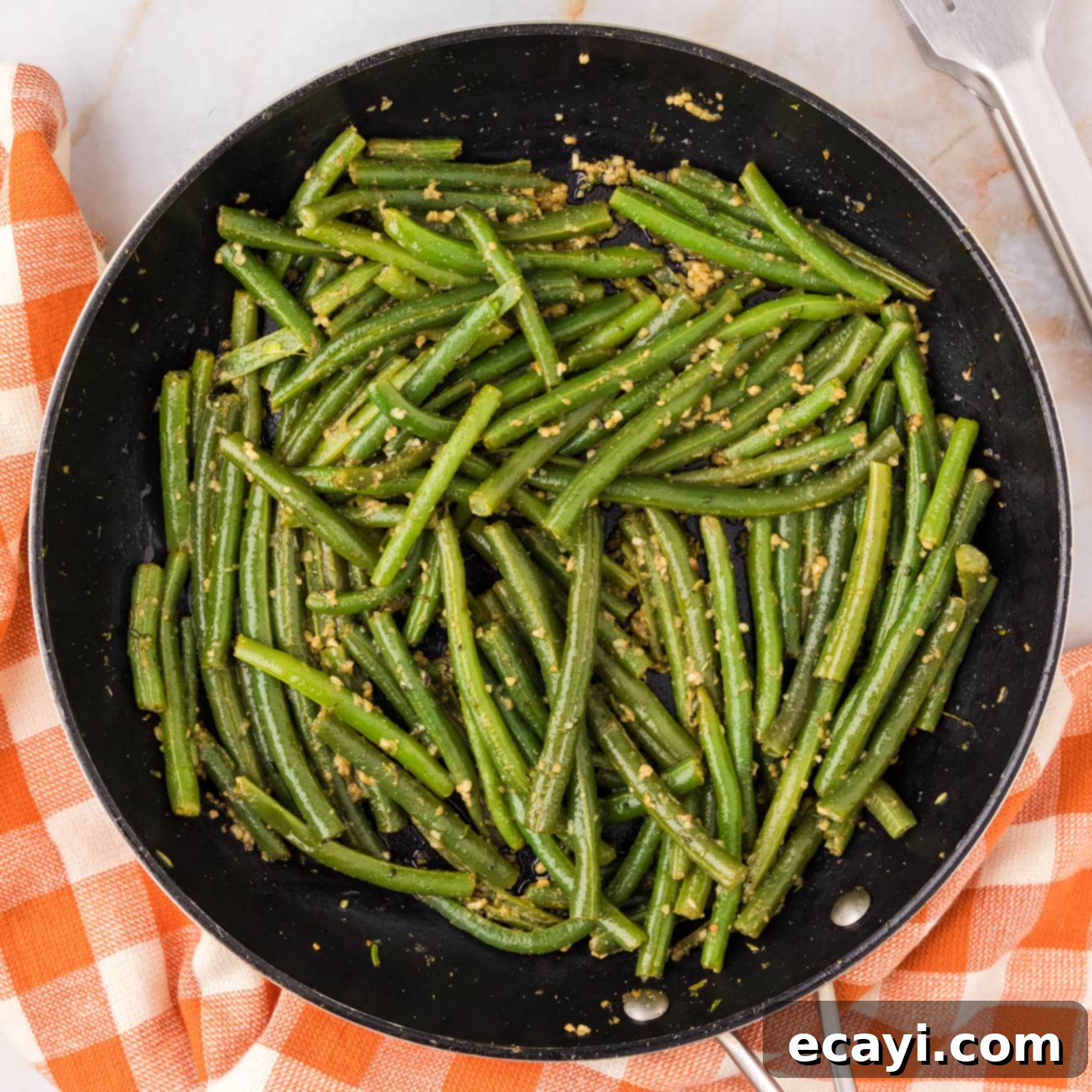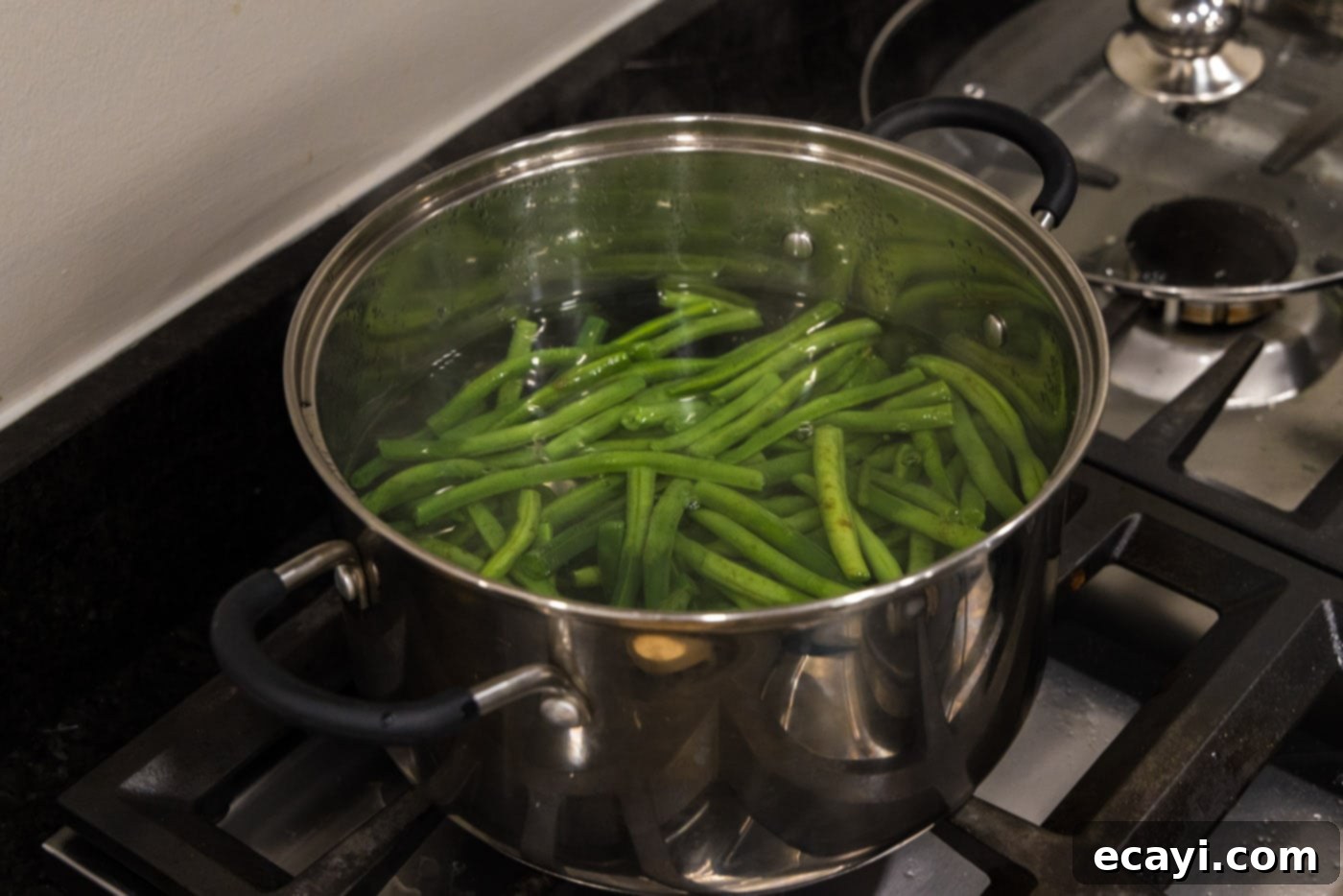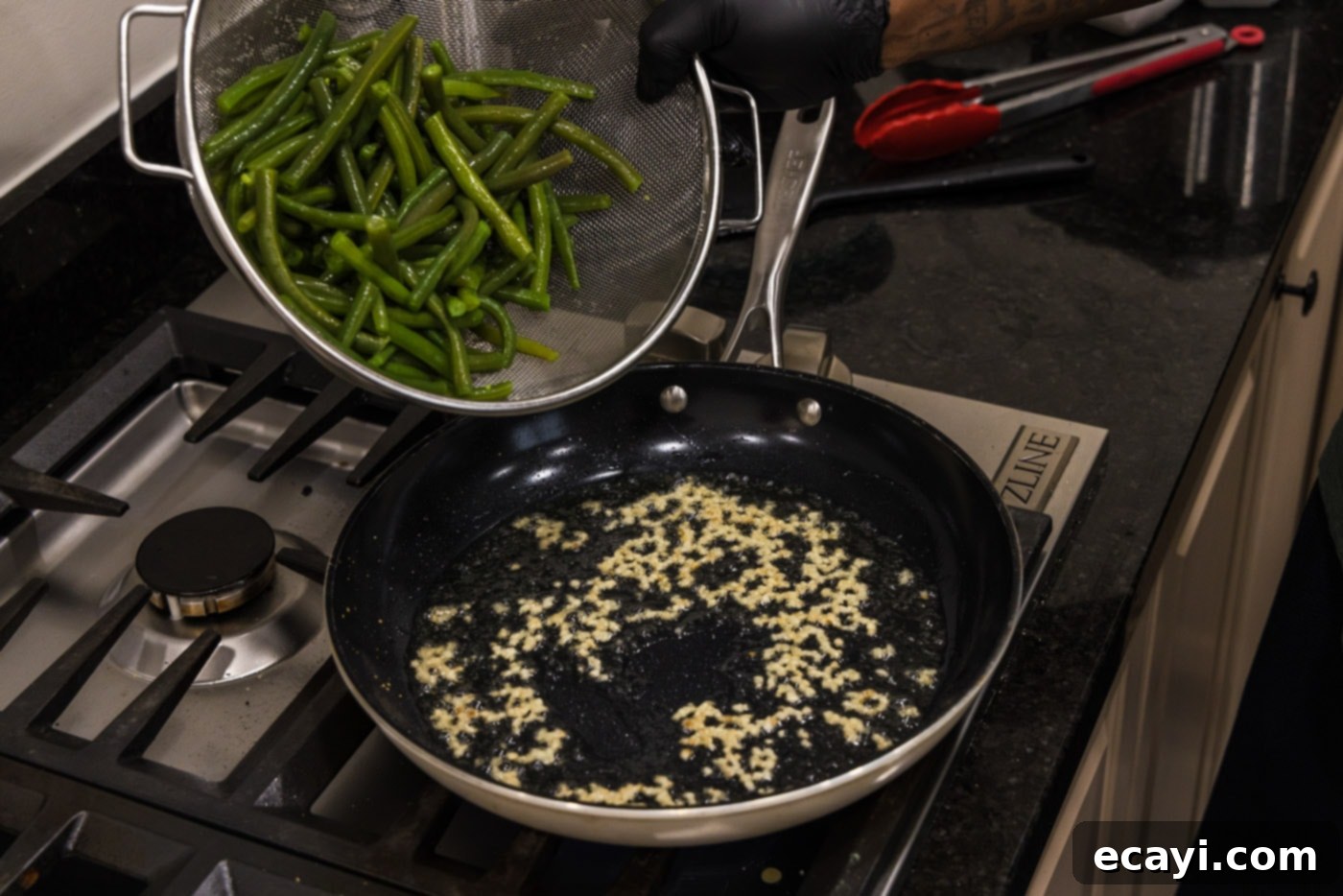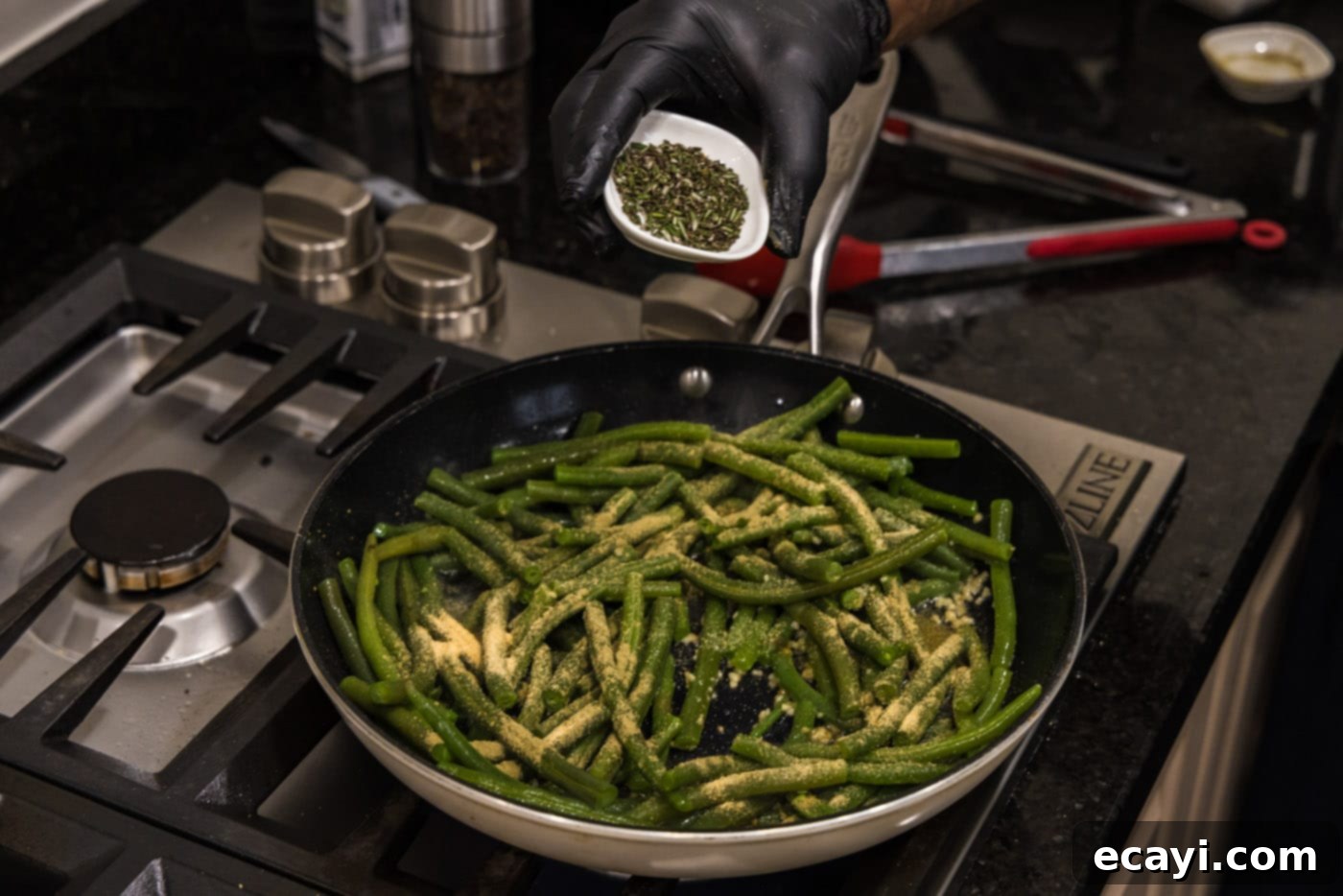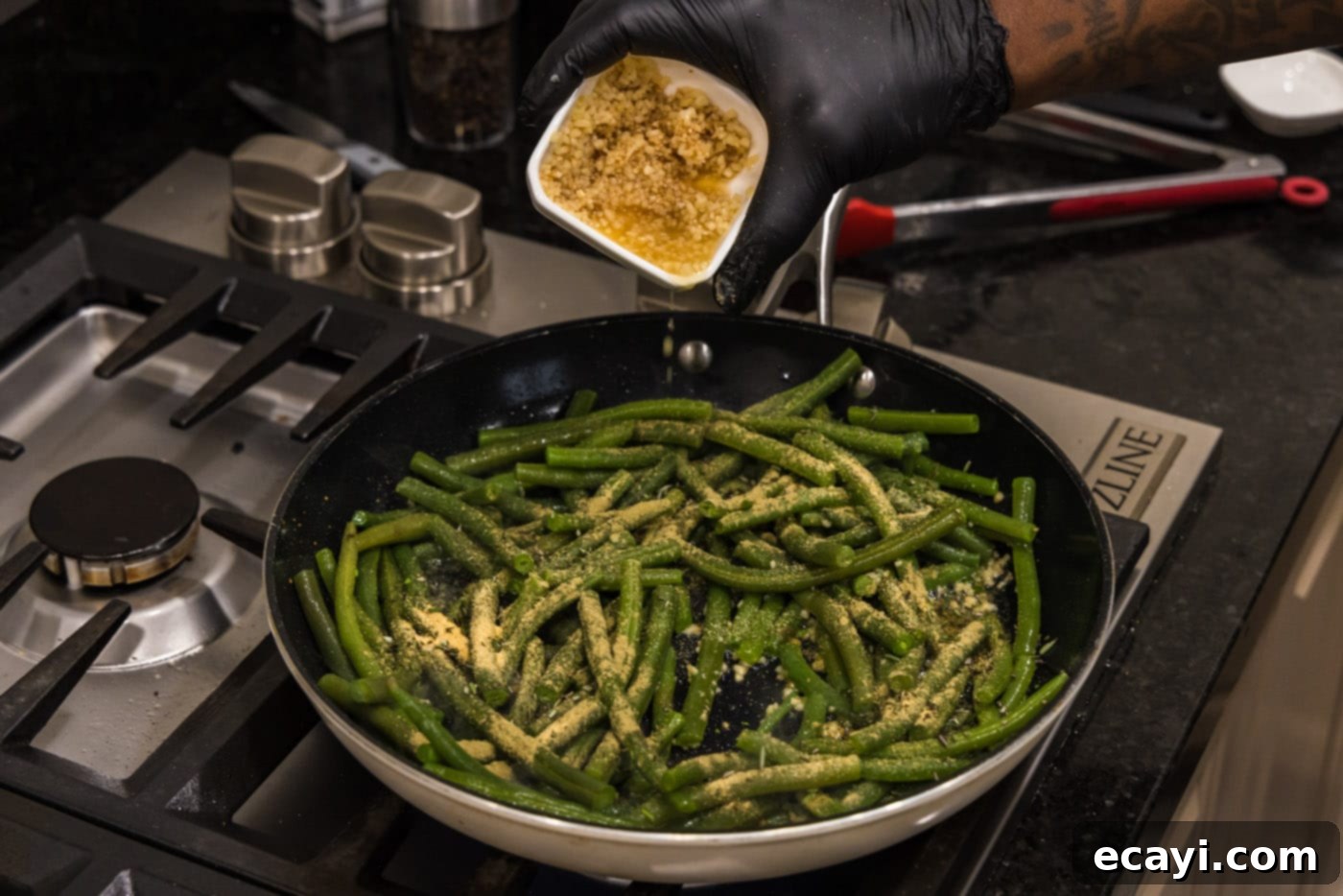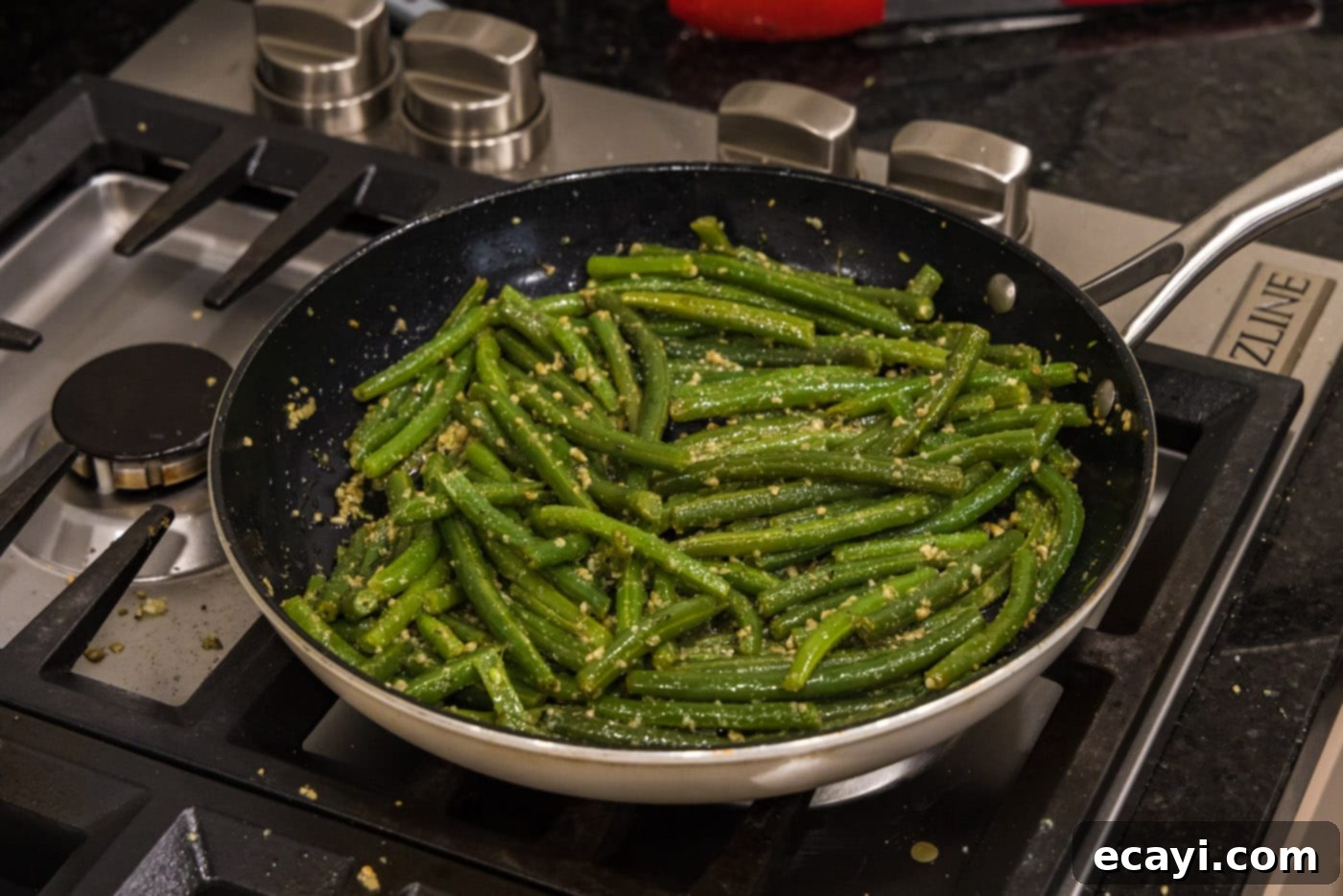Perfectly Sautéed Garlic Green Beans: An Easy & Flavorful Side Dish Recipe
Discover how to create tender, savory, and incredibly vibrant garlic green beans, bursting with the aromatic flavors of fresh garlic, fragrant sage, and earthy rosemary. This easy-to-follow recipe transforms simple green beans into an irresistible side dish that’s perfect for any occasion, from busy weeknights to elegant holiday dinners.
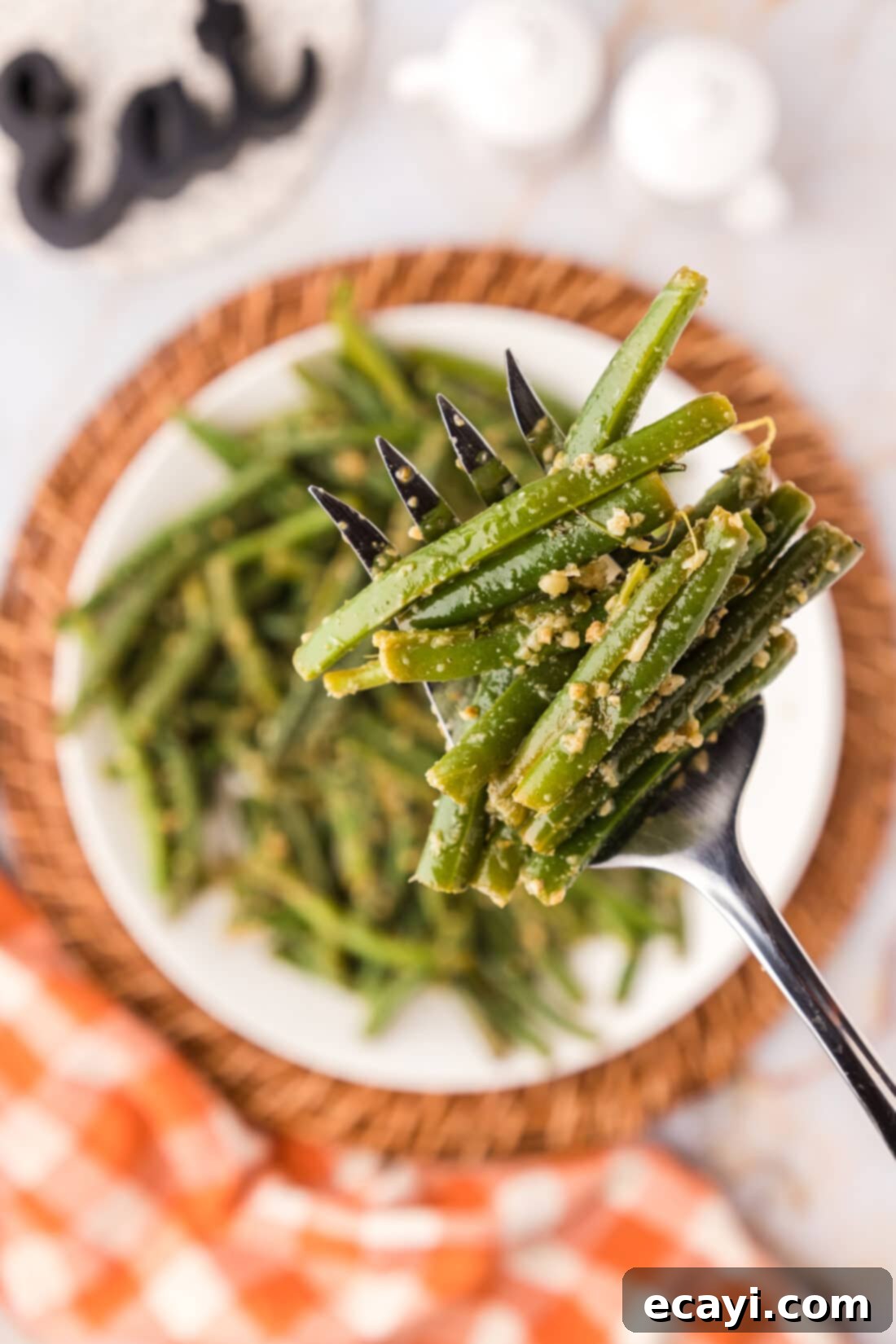
Why This Garlic Green Beans Recipe Works So Well
Having a reliable, delicious garlic green beans recipe in your culinary arsenal is truly essential. These green beans are not just a neutral and nutritious addition to any meal; they are packed with flavor and incredibly versatile. This particular recipe stands out because it employs a smart two-step cooking method: a quick boil followed by a cozy sear in a skillet with olive oil, an abundance of fresh garlic, and a fragrant blend of herbs. This technique ensures that your green beans achieve that perfect tender-crisp texture and retain their beautiful vibrant green color.
The initial blanching (brief boiling) tenderizes the green beans just enough, making them receptive to the flavors they’ll absorb in the skillet. It also locks in their bright green hue. Subsequently, sautéing them in a hot skillet with olive oil and fresh aromatics allows them to develop a slightly caramelized exterior and infuse them with deep, savory goodness. The generous use of minced garlic, ground sage, and fresh rosemary creates a truly unforgettable flavor profile that complements a wide array of main courses. Whether you usually lean towards roasted green beans, enjoy the convenience of air fryer green beans, or prefer the classic simplicity of sautéed green beans, you’ll find this method delivers an exceptional result. This simple yet sophisticated vegetable side dish is guaranteed to become a family favorite, effortlessly pairing with virtually any protein and making mealtime both easy and elevated.
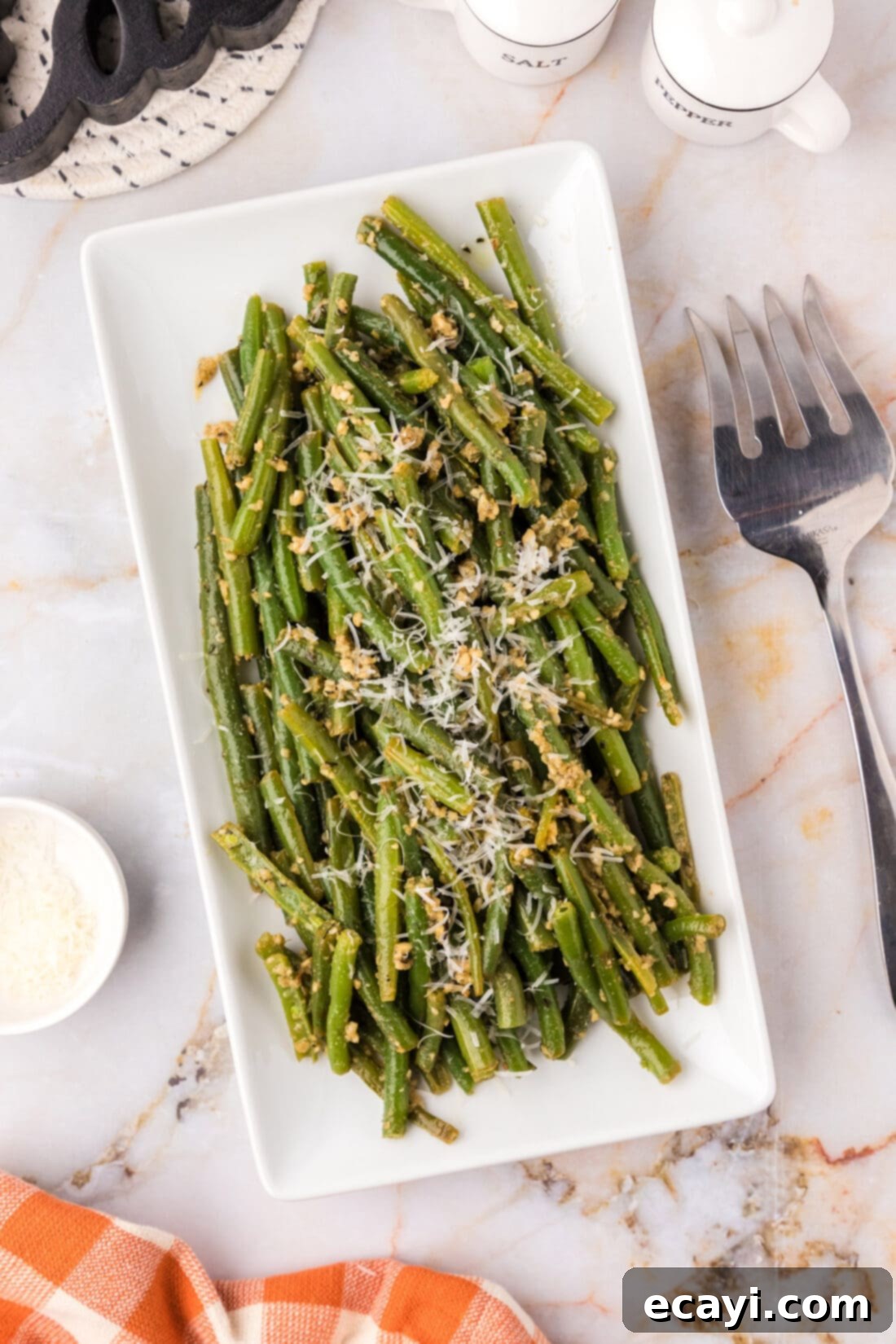
Ingredients You Will Need for Flavorful Green Beans
To prepare these delicious garlic green beans, you’ll need just a handful of fresh ingredients and pantry staples. Find all exact measurements, specific ingredients, and detailed instructions in the printable recipe card available at the very end of this comprehensive post.
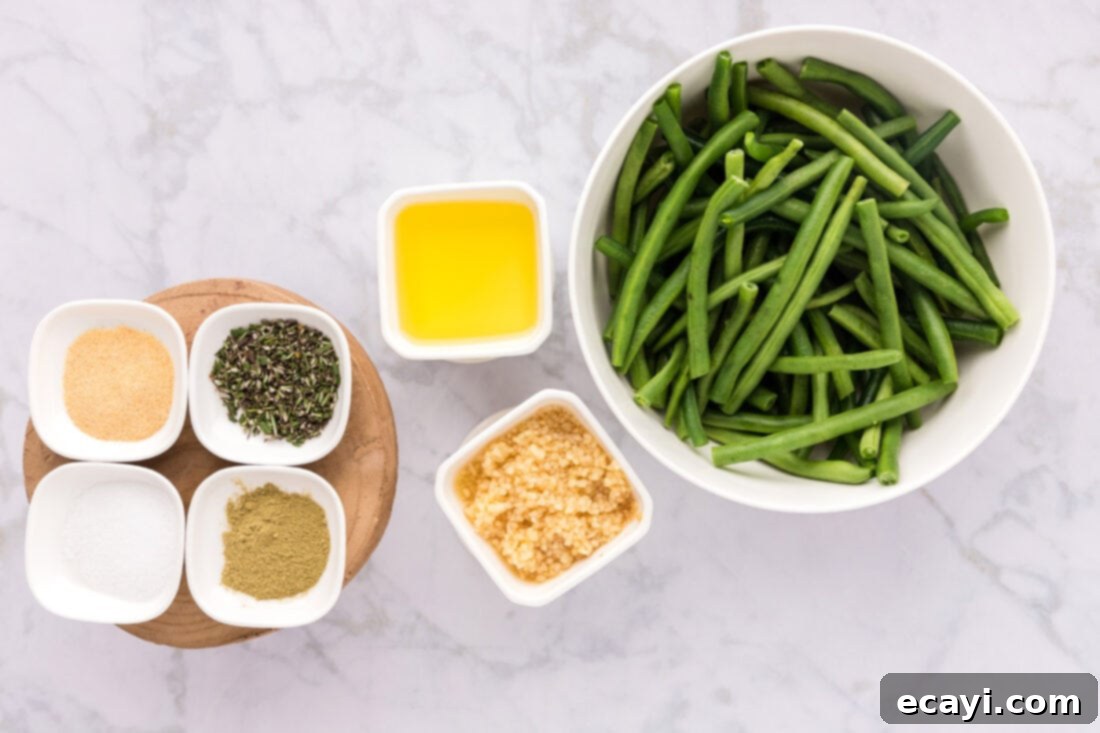
Ingredient Information and Smart Substitution Suggestions
Let’s dive deeper into the key ingredients that make these garlic green beans so exceptional, along with some helpful tips and substitution ideas to adapt the recipe to your preferences or what you have on hand.
- Green Beans: Freshness is paramount! Look for vibrant green beans that are firm and snap easily when bent. Avoid any with brown spots or limp texture. We personally love keeping our green beans long for a more elegant presentation, especially when serving guests. However, you can certainly trim them shorter into bite-sized pieces if that’s your preference or for easier eating. If fresh green beans aren’t available, you can use frozen green beans. Thaw them completely and pat them very dry before proceeding with the boiling step to prevent excess water from making your sautéed beans soggy.
- Minced Garlic: This recipe calls for a generous amount of minced garlic, and for good reason—it’s the star of the show! Freshly minced garlic provides the most potent and aromatic flavor. While pre-minced garlic from a jar can be used for convenience, fresh garlic will always yield superior results. The garlic is divided, with half cooked briefly at the start to build a flavorful base, and the rest added later to preserve its fresh, pungent kick.
- Olive Oil: A good quality extra virgin olive oil is ideal for sautéing as it adds a lovely depth of flavor and helps achieve a beautiful sear on the beans. If you don’t have olive oil, a neutral cooking oil like avocado oil or grapeseed oil can be used, though they won’t impart the same nuanced flavor. Butter can also be added for richness, either in combination with olive oil or on its own.
- Fresh Rosemary Leaves: Rosemary brings a wonderful piney, woody aroma to the green beans. Fresh rosemary is highly recommended for its potent fragrance, which really shines when lightly cooked. If you only have dried rosemary, use about 1/3 of the amount called for, as dried herbs are more concentrated. Crush it slightly between your fingers before adding to release its oils.
- Ground Sage: Sage offers a warm, earthy, and slightly peppery note that pairs beautifully with the garlic and rosemary. Ground sage is convenient and integrates well into the dish. If you have fresh sage, finely chop about twice the amount of ground sage specified.
- Garlic Powder: While fresh garlic provides the primary flavor, garlic powder adds another layer of mellow, roasted garlic essence that beautifully complements the fresh garlic. It ensures a consistent garlic presence throughout the dish.
- Salt: Essential for bringing out all the flavors! Start with the recommended amount and then season to taste at the end. Different salts (kosher, sea salt) have different granular sizes, so adjust accordingly. Freshly ground black pepper is also a fantastic addition for a little kick and aromatic finish.
With these robust ingredients, you’re well on your way to creating a side dish that’s far from ordinary!
How to Make Perfectly Sautéed Garlic Green Beans
These step-by-step photos and instructions are designed to help you visualize each stage of making this delicious recipe. For a convenient printable version of this recipe, complete with precise measurements and instructions, simply Jump to Recipe at the bottom of this post.
- Prepare the Green Beans: Begin by filling a large stock pot or a Dutch oven about two-thirds full with water. Place it over high heat and bring the water to a vigorous, rolling boil.
- Blanch the Green Beans: Once the water is at a rolling boil, carefully add the trimmed fresh green beans to the pot. Allow the water to return to a boil. As soon as the water reaches a full boil again, immediately turn off the heat. Let the green beans sit in the hot water for precisely 2 minutes. This brief blanching step will tenderize them slightly while preserving their vibrant color and crispness.
- Drain Thoroughly: Promptly drain the green beans in a colander, shaking off any excess water. It’s crucial that the beans are as dry as possible to ensure they sear beautifully in the skillet and don’t steam.
- Heat the Skillet: Place a large skillet (preferably a heavy-bottomed one) over medium-high heat. Add the olive oil and heat it until it’s shimmering, indicating it’s hot enough for sautéing.
- Sauté Garlic and Green Beans: Add half of the minced fresh garlic to the hot oil and cook for just one minute, stirring constantly, until it becomes fragrant. Be careful not to let it burn. Immediately add the drained green beans to the skillet. Using tongs, cook and toss the green beans for another minute or two, allowing them to absorb the garlic flavor and start to develop a slight char.


- Add Remaining Aromatics and Seasoning: Now, sprinkle the ground sage, garlic powder, fresh rosemary, and the remaining half of the minced garlic over the green beans in the skillet. Adding the fresh garlic later prevents it from burning and maintains its pungent flavor.


- Toss and Finish Cooking: Continue to toss the green beans with tongs to thoroughly incorporate all the herbs and garlic. Cook for an additional 3-4 minutes, or until the green beans reach your desired level of tenderness. They should be tender-crisp with a beautiful charred appearance.

- Season to Taste: Remove the skillet from the heat. Season the green beans with salt, adding more or less according to your personal preference. A pinch of black pepper can also be added for extra flavor. Serve immediately and enjoy!
Frequently Asked Questions & Expert Tips for Garlic Green Beans
Boiling or blanching the green beans before sautéing them is a key step to achieve that perfect tender-crisp texture and vibrant green color. It kickstarts the cooking process, ensuring the beans are tender on the inside without becoming mushy or overcooked during the sauté. This brief boil also helps the green beans retain their beautiful bright green hue. While it isn’t an absolutely necessary step, and you can certainly sauté them from raw if you prefer very firm and crispy green beans, we highly suggest this method for consistently delicious results that are tender-yet-firm.
Leftover garlic green beans can be stored in an airtight container in the refrigerator for up to 4 days. To reheat them, gently warm them in a skillet over medium-low heat with a small drizzle of fresh olive oil. Avoid microwaving, as it can make them less crisp. If needed, you can add a tiny splash of water or broth to prevent them from drying out.
Yes, you can definitely use frozen green beans! For best results, allow them to thaw completely before cooking. After thawing, pat them thoroughly dry with paper towels to remove any excess moisture. Then, you can proceed with the boiling step as directed in the recipe, or even skip the boil and go straight to sautéing if they are already quite tender from blanching before freezing. Just be mindful not to overcook them, as frozen beans can sometimes cook faster.
This recipe provides a fantastic base, but feel free to get creative! A squeeze of fresh lemon juice or a sprinkle of lemon zest at the end can brighten the flavors. For a touch of heat, add a pinch of red pepper flakes with the garlic. A drizzle of balsamic glaze or a sprinkle of Parmesan cheese (as shown in some of our photos) after cooking also adds a delicious finish. You could also experiment with other herbs like fresh thyme or oregano, or even a mix of Italian herbs.
The key to preventing soggy green beans lies in two main aspects: not over-boiling them and ensuring they are thoroughly drained and dry before they hit the hot skillet. The initial boil should be brief—just until the water returns to a boil, then 2 minutes off the heat. Immediately drain them in a colander and shake off as much water as possible. When sautéing, make sure your skillet is hot and not overcrowded. If you’re cooking a large batch, consider doing it in two smaller batches to ensure proper searing and crispness.
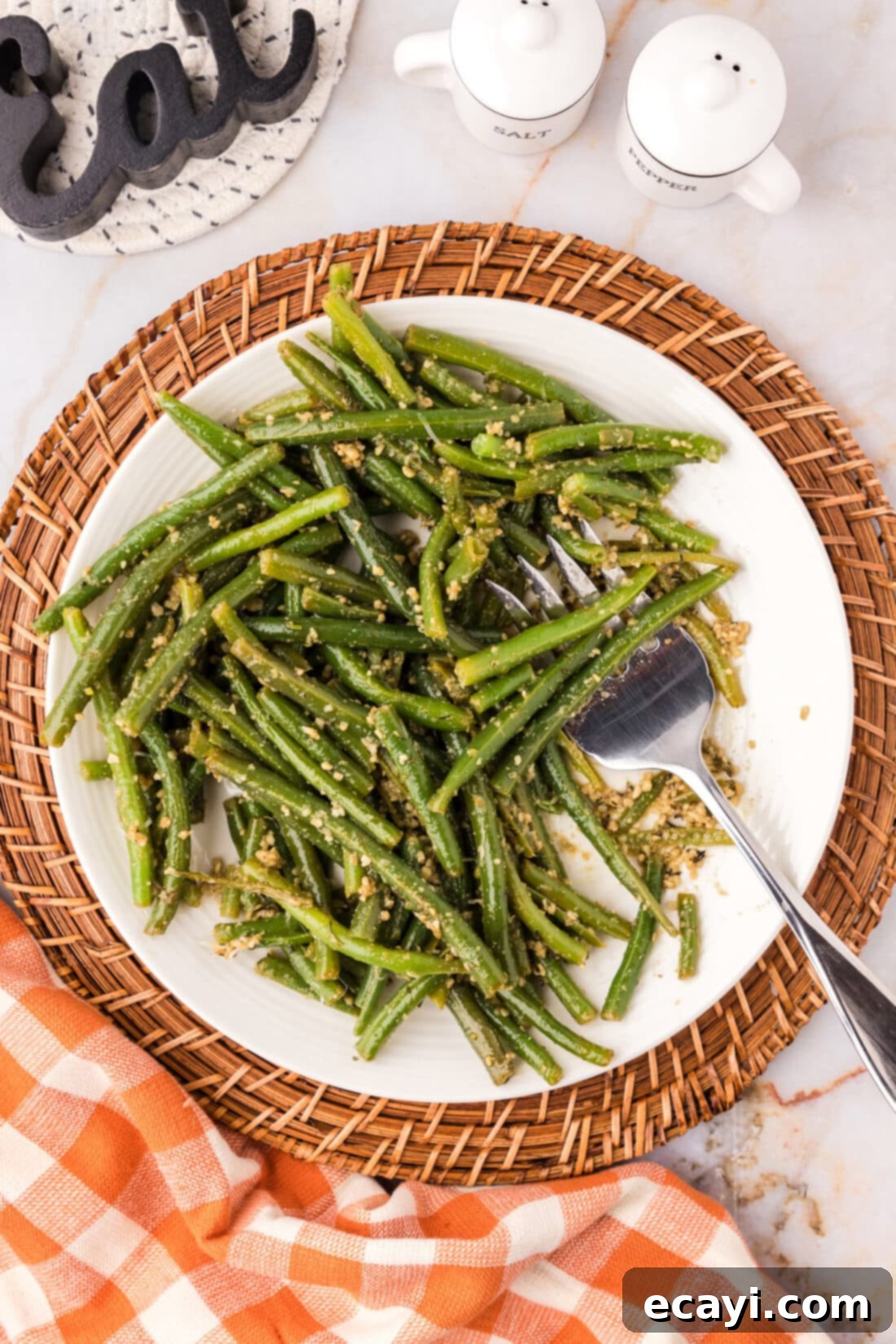
Serving Suggestions for Garlic Green Beans
Because garlic green beans offer such a wonderfully balanced and savory flavor profile, they truly are a neutral yet delicious side dish that pairs beautifully with an incredibly wide array of main courses. Their vibrant color and fresh taste complement rich flavors without overwhelming them, making them a versatile choice for almost any meal. Whether you’re preparing beef, chicken, seafood, or pork, a side of these perfectly sautéed green beans will enhance your dining experience.
Consider serving them alongside classic comfort foods or more sophisticated dishes. They are excellent with brown sugar salmon for a sweet and savory pairing, a robust cast iron ribeye, or a flavorful honey garlic chicken breast. Other fantastic pairings include roasted chicken, pan-seared scallops, tender pork chops, or even a hearty vegetarian lentil loaf. For an extra touch of gourmet elegance and a boost of savory, salty flavor, we highly recommend garnishing your finished garlic green beans with a sprinkle of freshly grated Parmesan cheese. A dash of red pepper flakes can add a subtle kick, or a squeeze of fresh lemon juice can brighten up the entire dish, making it pop.
More Delicious Related Recipes to Explore
If you loved these garlic green beans, you might enjoy trying some of our other easy and flavorful vegetable and side dish recipes:
- Sautéed Zucchini
- Sautéed Asparagus
- Garlic Butter Shrimp
- Garlic Roasted Potatoes
- Southern Green Beans
- Green Beans Almondine
I love to bake and cook and share my kitchen experience with all of you! Remembering to come back each day can be tough, that’s why I offer a convenient newsletter every time a new recipe posts. Simply subscribe and start receiving your free daily recipes!
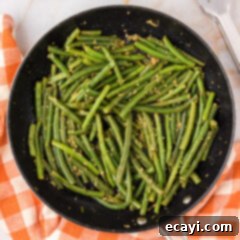
Garlic Green Beans
IMPORTANT – There are often Frequently Asked Questions within the blog post that you may find helpful. Simply scroll back up to read them!
Print It
Pin It
Rate It
Save ItSaved!
Ingredients
- 3 cups fresh green beans ends trimmed
- 3 Tablespoons minced garlic divided
- 4 Tablespoons olive oil
- 1 Tablespoon chopped fresh rosemary leaves
- 1 teaspoon ground sage
- 3 teaspoons garlic powder
- 1 teaspoon salt or to taste
Things You’ll Need
-
Stockpot or dutch oven
-
Large heavy bottomed skillet
Before You Begin
- We prefer our green beans long as they look nicer for presentation. You can cut yours shorter if you like.
Instructions
-
Fill a stock pot or Dutch oven 2/3 full with water. Bring pot to a rolling boil.
-
Add green beans to the boiling water and bring back to a boil. When water comes back to a boil and turn off the heat. Allow to sit for 2 minutes.
-
Drain green beans in a colander.
-
Heat olive oil in skillet over medium-high heat until shimmering.
-
Add half of the minced garlic and cook for one minute. Add green beans. Use tongs to cook and toss for a minute or two.
-
Sprinkle on ground sage, garlic powder, rosemary, and remaining minced garlic.
-
Toss with tongs to incorporate ingredients. Cook for 3-4 minutes.
-
Season to taste with salt.
Expert Tips & FAQs
- Store leftovers in an air-tight container kept in the refrigerator for up to 4 days. Reheat in a skillet over medium-low heat with a drizzle of olive oil.
Nutrition
The recipes on this blog are tested with a conventional gas oven and gas stovetop. It’s important to note that some ovens, especially as they age, can cook and bake inconsistently. Using an inexpensive oven thermometer can assure you that your oven is truly heating to the proper temperature. If you use a toaster oven or countertop oven, please keep in mind that they may not distribute heat the same as a conventional full sized oven and you may need to adjust your cooking/baking times. In the case of recipes made with a pressure cooker, air fryer, slow cooker, or other appliance, a link to the appliances we use is listed within each respective recipe. For baking recipes where measurements are given by weight, please note that results may not be the same if cups are used instead, and we can’t guarantee success with that method.
